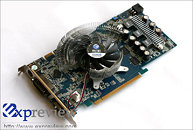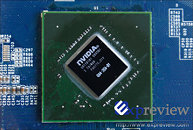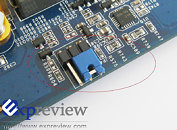- Joined
- Oct 9, 2007
- Messages
- 47,853 (7.38/day)
- Location
- Dublin, Ireland
| System Name | RBMK-1000 |
|---|---|
| Processor | AMD Ryzen 7 5700G |
| Motherboard | Gigabyte B550 AORUS Elite V2 |
| Cooling | DeepCool Gammax L240 V2 |
| Memory | 2x 16GB DDR4-3200 |
| Video Card(s) | Galax RTX 4070 Ti EX |
| Storage | Samsung 990 1TB |
| Display(s) | BenQ 1440p 60 Hz 27-inch |
| Case | Corsair Carbide 100R |
| Audio Device(s) | ASUS SupremeFX S1220A |
| Power Supply | Cooler Master MWE Gold 650W |
| Mouse | ASUS ROG Strix Impact |
| Keyboard | Gamdias Hermes E2 |
| Software | Windows 11 Pro |
The GeForce 9600 GT Green Edition is NVIDIA's newest SKU that is based on an energy-efficient variant of the GeForce 9600 GT graphics processor. The SKU maintains the G94 GPU design, except for that it is built on the newer 55 nm silicon process (model: G94-350-B1), that is expected to add to its energy efficiency, also that the GPU makes do with a lower core voltage of around 1.0V from its original 1.1V figure on the 65 nm variant. At its default voltage setting the GPU uses reference clock speeds of 625/1625/900 MHz (core/shader/memory).
Galaxy designed its first accelerator based on the new GPU, to which it added its own set of innovations. The card uses a jumper to allow users to manually set the GPU voltage. At its default state (pins 1-2 short), the GPU operates at 1.0V, but when pins 2-3 are short, the GPU voltage enters a "pressurized state" (increases). When the jumper is removed (neither pins short), the GPU voltage plummets to 0.8V. The Galaxy accelerator needs the 6-pin PCI-E power connector for operation. The GPU is cooled by a classic Zalman VF703 Al cooler, while the memory is passively cooled under its air-flow.



View at TechPowerUp Main Site
Galaxy designed its first accelerator based on the new GPU, to which it added its own set of innovations. The card uses a jumper to allow users to manually set the GPU voltage. At its default state (pins 1-2 short), the GPU operates at 1.0V, but when pins 2-3 are short, the GPU voltage enters a "pressurized state" (increases). When the jumper is removed (neither pins short), the GPU voltage plummets to 0.8V. The Galaxy accelerator needs the 6-pin PCI-E power connector for operation. The GPU is cooled by a classic Zalman VF703 Al cooler, while the memory is passively cooled under its air-flow.



View at TechPowerUp Main Site
Last edited:




 )
) ), results in 8 degress lower under full loading using the same cooling fan, not a bad result indeed.
), results in 8 degress lower under full loading using the same cooling fan, not a bad result indeed. Good to know the 6pin is gone is for sure!
Good to know the 6pin is gone is for sure!